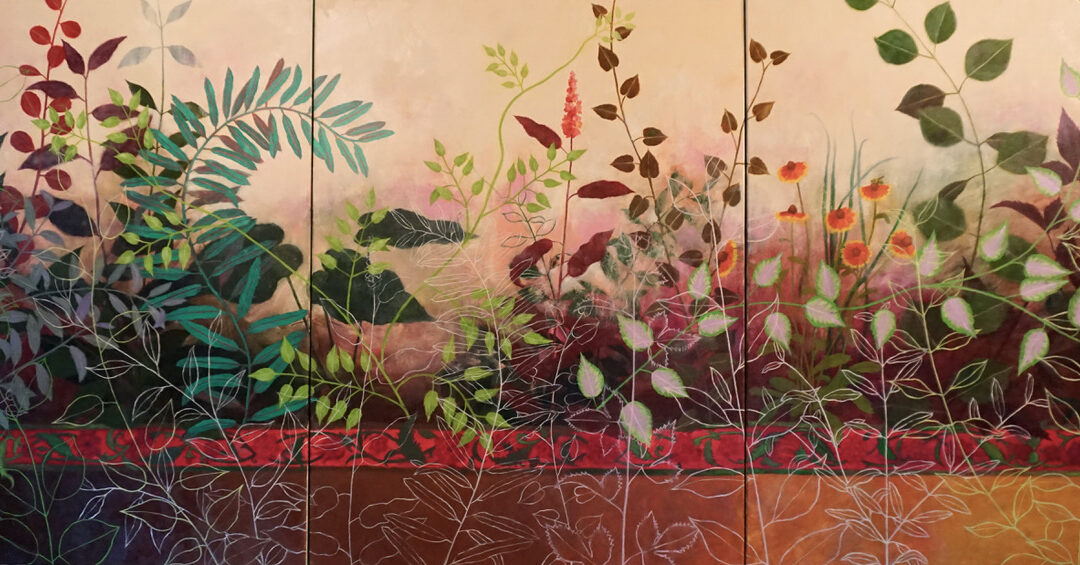Essay by art critic Richard Speer
The imagery in Tamara English’s new series, Verdancy Within, is lushly botanical: blanketflower and ninebark, jasmine and mock orange, calla lily and sage twisting, branching, reaching, subtly stylized from northern Indian and Middle Eastern tiles and textiles or wholly abstracted from the artist’s fertile imagination. The soil from which the vegetation springs appears to be visible too, and beneath it, rendered in outline as though transparent, the vines and leaves soon to sprout; but appearances alone rarely tell the full story, and English sees far more than what the eye can physically apprehend. Beyond the literal, she sees the potential energy held in store by the vegetation in the paintings’ lower quadrant, which to her represents “the imaginal, idea, or intention, rooted in the Divine Mother, rising from the Ground of Being through the causal and subtle fields.” It is a vision of heightened awareness verging into magical realism, suggesting a wondrous presence in the process of unfolding.
This luxuriant visual syntax is both a departure and a return to form for English, who since 2004 has deployed a vocabulary of signature motifs to elucidate the indivisibility of the physical and the numinous. While the body of work that preceded this one, The Great Uplift, depicted fantastical islands floating above landscapes and open sea, the Edenic fronds and tendrils in the current paintings are rooted in levels of awareness within the spirit-infused self. Hierarchies fall away in this depiction. The machinations of the inner world affect the world beyond the self: As within, so without. From the vegetal kingdom we extrapolate to the integrated human body, mind, and spirit. In this reading, the soil is the context that nourishes our growth, the beauty that feeds us and in turn blossoms into the universe. That beauty is generative and causal, its hidden interiority commensurate with its externalization. In his collected lyric poems, the Divan-i Shams, the 13th-Century poet Rumi invoked “tender words… sealed in the sacred vaults of heaven,” falling to the earth and growing “green all over the world.” So, too, in English’s paintings, seeds sealed away within soil, or spirit, soon will sprout and green the world.
Five-hundred years after Rumi’s time, at the zenith of the French Enlightenment, Voltaire ended his iconic novella, Candide, with the injunction, “We must cultivate our garden.” In Eastern and Western traditions alike, the earthly garden conflates to the spiritual. If we tend the garden within, it follows, that garden, too, will bear fruit. In this light, it is notable that English finds resonance in the 2021 book The Awakened Brain by Lisa Miller, PhD. Citing studies of MRI imagery, Miller found that key physical structures in the brains of subjects with regular spiritual practices were healthier than those of subjects without spiritual practices. Healthier brains support greater mental acuity and emotional well-being, ergo, a direct link between spiritual practice and mental/psychological functionality—a corroboration of inner spiritual life supporting our actions in the wider world.
Beyond the scope of this compelling scientific research, Verdancy Within speaks to more broadly universal themes—as English characterizes it, “to living in alignment with our ideals in such a way that we become them.” The paintings invite us to fully experience the day-to-day, minute-to-minute joys and challenges of our strengths and limitations, our capacity to love even in the face of adversity, our life’s mission and deepest karma, with an awareness so intense, we come to literally embody our dearest-held aspirations and values.
To concentrate such a caliber of profundity within the construct of an oil painting, even a highly symbolic one, is a remarkable feat. Certainly, a casual viewer would not have to grasp these works’ conceptual frameworks in their entirety to appreciate their complex compositions, vivid color, and luscious surfaces as pure objets d’art. But closer consideration yields exponential rewards when the paintings in question are not only sumptuous still lifes, but teaching tools for accessing the bounties we dually contain and manifest.
—Critic, curator, and author Richard Speer has written reviews and essays for ARTnews, The Los Angeles Times, The Chicago Tribune, and Salon and is the author of two-dozen books about historical and contemporary artists. He has curated exhibitions in California and the Pacific Northwest, most recently the critically acclaimed “Sam Francis and Japan” at LACMA. For more information, please visit richardspeer.com.


Recent Comments